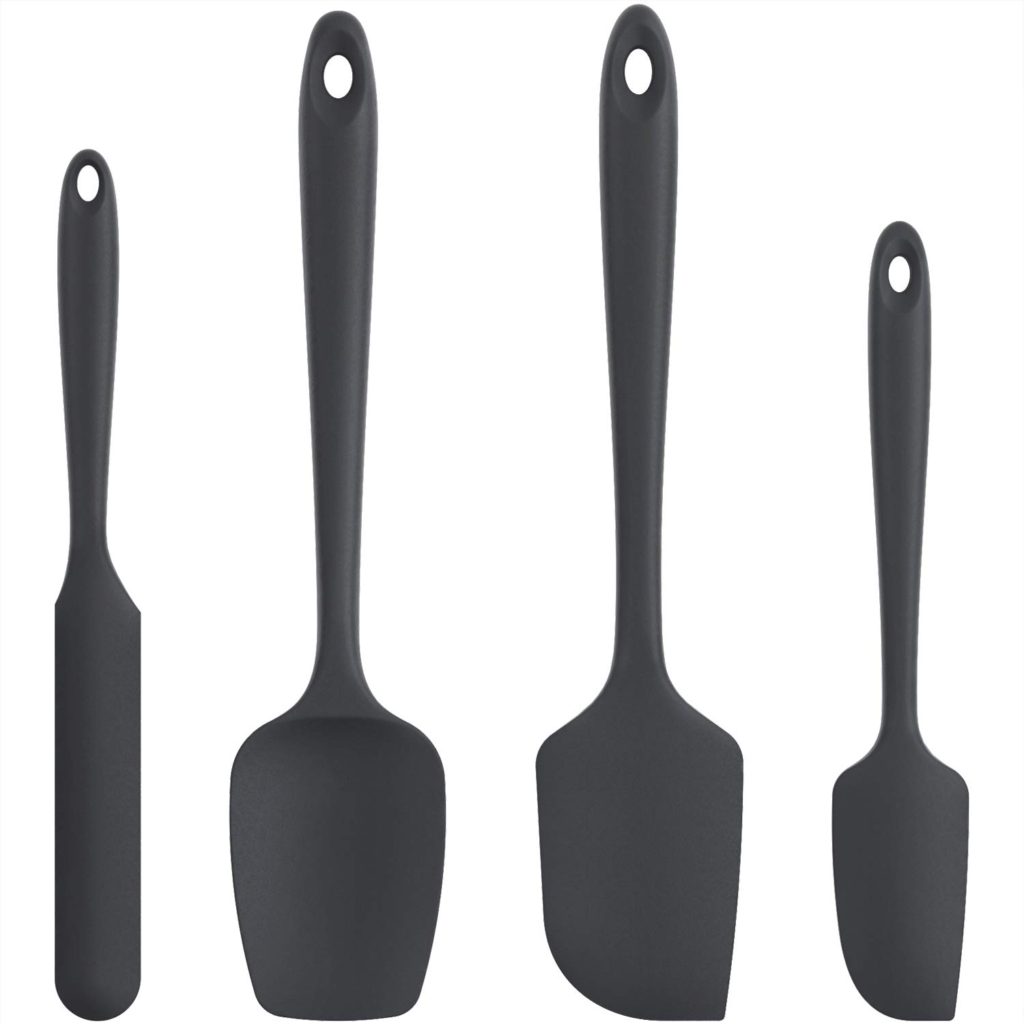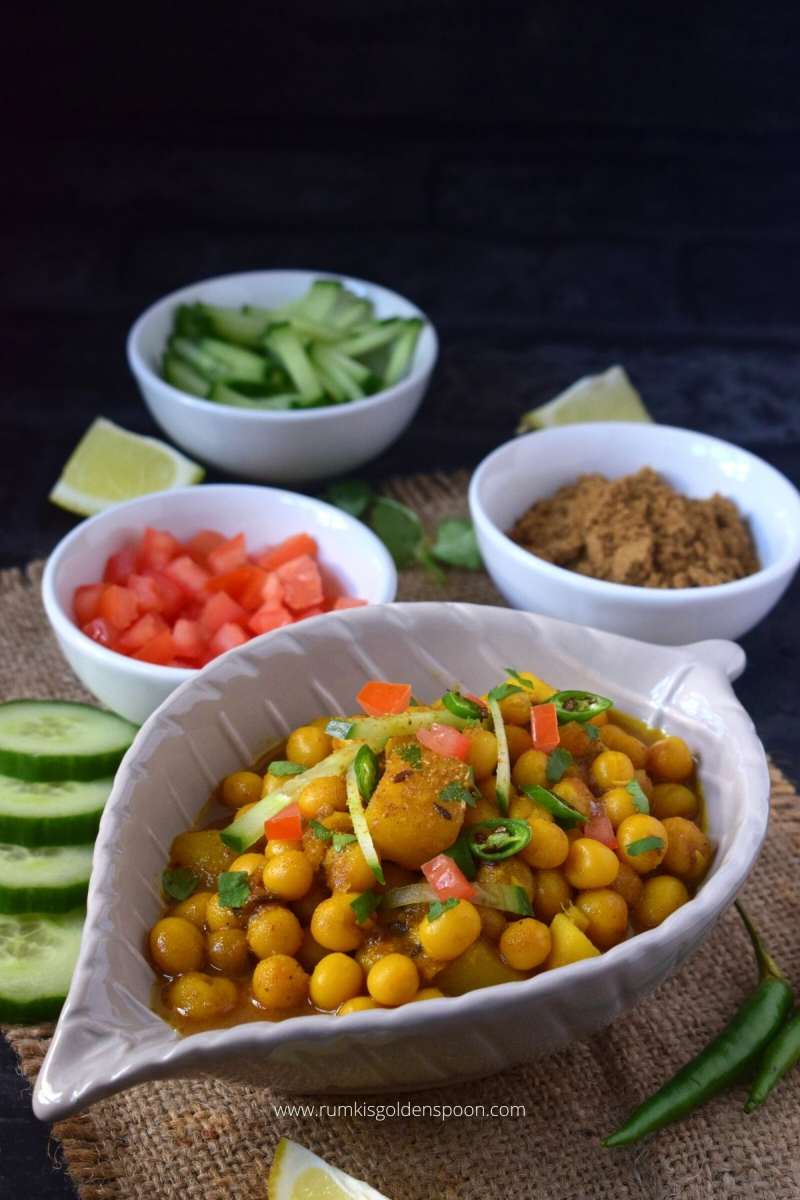Niramish ghugni aka niramish ghugni recipe Bengali is a luscious, light and mildly spicy yellow peas stew and one of the most beloved Kolkata street food. It is a crazily popular no onion no garlic recipe which is perfect for Bengali vegetarian days and puja days. In this preparation, boiled yellow peas or white peas are cooked with tomato, potato chunks and Bengali spice mix bhaja masala. Niramish ghugni recipe is mostly served as a side with luchi or rotis.
Though ghugni recipe is crazily popular in West Bengal, Orissa and a few other subcontinents of east India but many of us are not aware of the dish ‘Ghugni’.
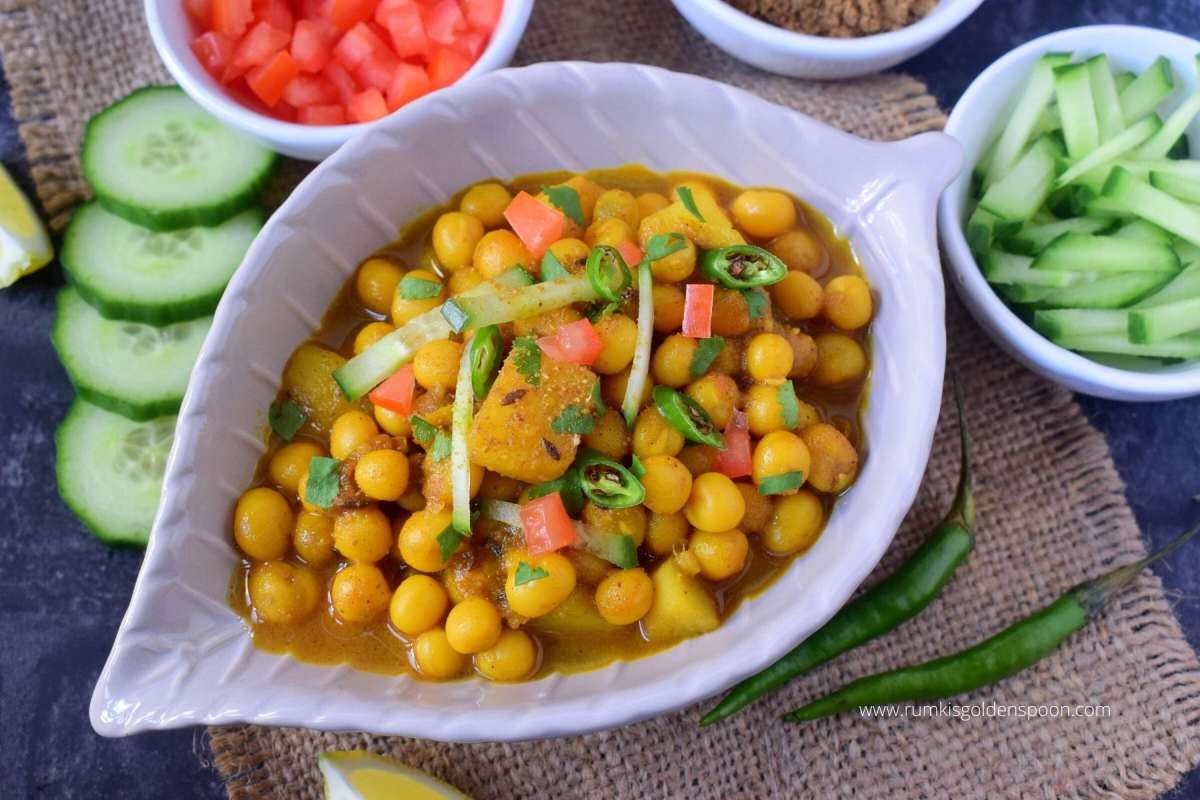
Table of Contents
About the recipe
Tips and Suggestions
How to make Niramish ghugni (step wise photos)
Recipe Card
What is ghugni?
Ghugni is a simple whole yellow pea or Matar (Motor) curry where yellow pea is soaked overnight and then boiled before preparing the curry. It is a semi-liquid curry that is neither too watery nor dry in texture with intact boiled matars. Ghugni is one of the staple breakfast or snacks recipes in Bengal, Orissa and it can be prepared in myriad ways.
Types of ghugni
Usually, ghugni recipe is prepared in two different ways. One is mangsher ghugni or keema ghugni which is prepared mostly for special occasions and another type is niramish ghugni. In niramish ghugni, it is subdivided into two different types. One is niramish ghugni with onion and garlic and another is niramish ghugni without onion-garlic. Most of the street vendors of Kolkata serves the no onion no garlic niramish ghugni recipe in their stalls.
How to serve ghugni?
Ghugni recipe is served in many ways for breakfast or as evening snacks. Sometimes, it is simply served with some chopped onion, chopped green chillies, some lemon juice and a pinch of bhaja masala as snacks in disposable shaal leaves bowl.
Sometimes, it is simply served with muri or puffed rice which is also known as murmura.
Luchi-ghugni is a classic breakfast recipe for any Bengali for ages. In fact, it can pair up with rotis and chapatis for dinner.
Other than these, ghugni chaat can also be prepared by simply topping some imli ki chutney, green chutney, chopped onion, chopped green chillies and some sev on ghugni recipe bengali.
In short, ghugni recipe is one of the most versatile mildly spicy curries which can get fitted at any time in our diet.
Whenever I talk about niramish ghugni recipe Bengali, it always makes me feel nostalgic. As a bong, I have grown up eating this delicacy and till now never get bored with it. I still remember how my mother used to prepare niramish ghugni in a large Kadai in Vijaya Dashami. She used to serve it as a side with phulko luchi to all the relatives and friends who came to visit our house for elders’ blessings, and everybody used to devour that with immense pleasure.
Today, I am going to share the niramish ghugni recipe without onion and garlic with you. Honestly, the whole trick to preparing a perfect ghugni recipe mainly depends on two things.
- Boil the yellow pea or matar perfectly so it gets cooked and remains intact.
- Use of Bengali bhaja masala. The flavour of ghugni will always remain incomplete without this Bengali spice mix.
Other than these, preparing niramish ghugni recipe at home is a super easy task. It is a simple recipe that gets prepared very quickly without investing much time. The best part of the recipe is that you don’t need to drop your tears for slicing onions. You can double or triple the amount without investing any extra time or effort. All the ingredients to prepare the niramish ghugni recipe is very common and easily available in any Bengali kitchen pantry.
Niramish ghugni recipe with step by step photos and instructions have been provided in the ‘Instruction’ section of the recipe. If you follow each step of my recipe precisely then you will get ghugni matar with perfect flavour and consistency which will taste even better than the market bought ones. I have included all the tips and tricks below to prepare a perfect ghugni.
Tips to prepare perfect ghugni
- To prepare a perfect ghugni recipe, it is very important to soak the dried white peas or yellow peas overnight or at least for 8 hours or else the ghugni will not get cooked properly.
- Secondly, boil the pea or matar very carefully so that they just get cooked and at the same time, remain whole without losing their shape.
- The consistency of ghugni recipe is neither too thick nor too runny. It is moderate in consistency. So, be careful during the time of adding water for the gravy.
- Use mustard oil to cook the niramish ghugni. It gives nice flavour and better taste to the dish.
- Use the yellow pea stock for the gravy. It gives a better flavour to the dish.
- Don’t skip bhaja masala. It is the most necessary component to flavour up the ghugni.
Bhaja masala recipe aka Bengali bhaja masala is one of the most important spices of Bengali culinary. It is the spice mixture of a few different types of whole spices which are dry roasted and ground to fine dust after cooling down. This spice blend creates a magnificent aroma. Bhaja masala is one of the key ingredients of flavouring Ghugni, mangsher ghugni, phuchka, vegetable chop, Bengali singara, Niramish alur dom, aam pora sarbat, aamer achar, kuler achar and many more. Countless recipes have been enhanced with this magical spice mix.
How to make ghugni?
To prepare the ghugni, first soak the yellow peas for 8 hours or for overnight in a large bowl with enough water. On the next day, drain the water and wash the soaked peas a couple of times.
Transfer the peas to the pressure cooker and add salt, turmeric powder, water into the cooker and give a stir. Close the lid of the cooker and pressure cook it in medium flame for 2-3 whistles. Then allow the pressure cooker to release its pressure. Preserve the stock and boiled peas separately for later use.
Now put a pan on flame and add mustard oil into it. Once the oil is hot, add dry red chillies, bay leaf, cinnamon stick, cumin seeds into the pan and let them crackle.
Then add potato chunks into the pan and mix it. Cook it in medium-high flame for a minute. Add salt, turmeric powder, red chilli powder into the pan and mix them well. Cook it in medium flame for another 2-3 minutes.
Add ginger paste and give a nice stir. Cook it in low flame for another couple of minutes so that the raw smell disappears.
Add tomato pieces, green chillies into the pan and mix it well. Cover the pan and cook it on low flame for 2-3 minutes until the tomatoes get soft.
Add cumin powder, coriander powder into the pan and mix it well. Cook the masala in the lowest flame for 1-2 minutes.
Add boiled yellow peas into the pan and mix them well. Cover the pan and cook it for another couple of minutes. Add the boiled yellow pea stock into the pan and give a nice stir.
Cover the pan and allow the gravy to boil. Then put the flame in low and add sugar, bhaja masala, garam masala powder into it. Allow the gravy to simmer in the lowest flame for a few minutes. Then switch off the flame and put the pan down.
Many Kolkata street food recipes have already been shared in my previous posts. You can check a few of them like
Vegetable chop recipe
Bengali singara recipe
Kolkata egg roll
..And Many more…
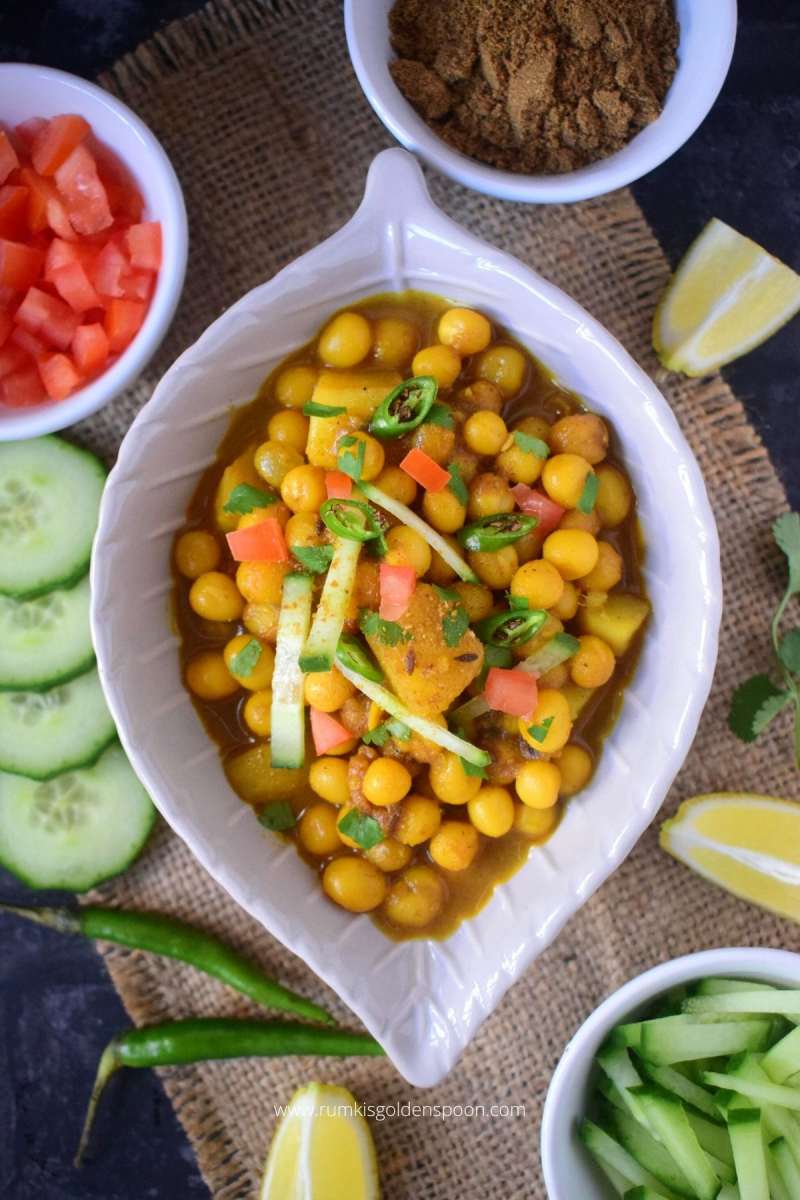
Ingredients:
To pressure cook the peas
- 1 cup dried white or yellow Peas
- 2½ cups Water
- ½ teaspoon Turmeric powder
- 1 teaspoon Salt
Other ingredients for Niramish ghugni
- 1 large Potato, medium diced
- 1 large Tomato, deseeded and diced
- ½ tablespoon Ginger paste
- 2 green Chillies, whole or half slit
- 1 Bay leaf
- 2 dry red Chillies
- 1-inch Cinnamon stick
- ½ teaspoon Cumin seeds
- ½ teaspoon Turmeric powder
- 1 teaspoon red Chilli powder
- ½ teaspoon Cumin powder
- ½ teaspoon Coriander powder
- ¼ teaspoon Garam masala powder
- ½ tablespoon Bhaja masala
- 1 teaspoon Sugar
- 2 cups boiled pea stock, for the gravy
- 2 tablespoons Mustard oil, for cooking
Instructions:
- Take the dried peas in a large bowl and soak them with enough water overnight or at least for 8 hours. The dried peas will increase in size after getting soaked. So, it is important to soak it in a large bowl as compared to the volume of the dried peas. Drain the water and wash the soaked peas nicely.
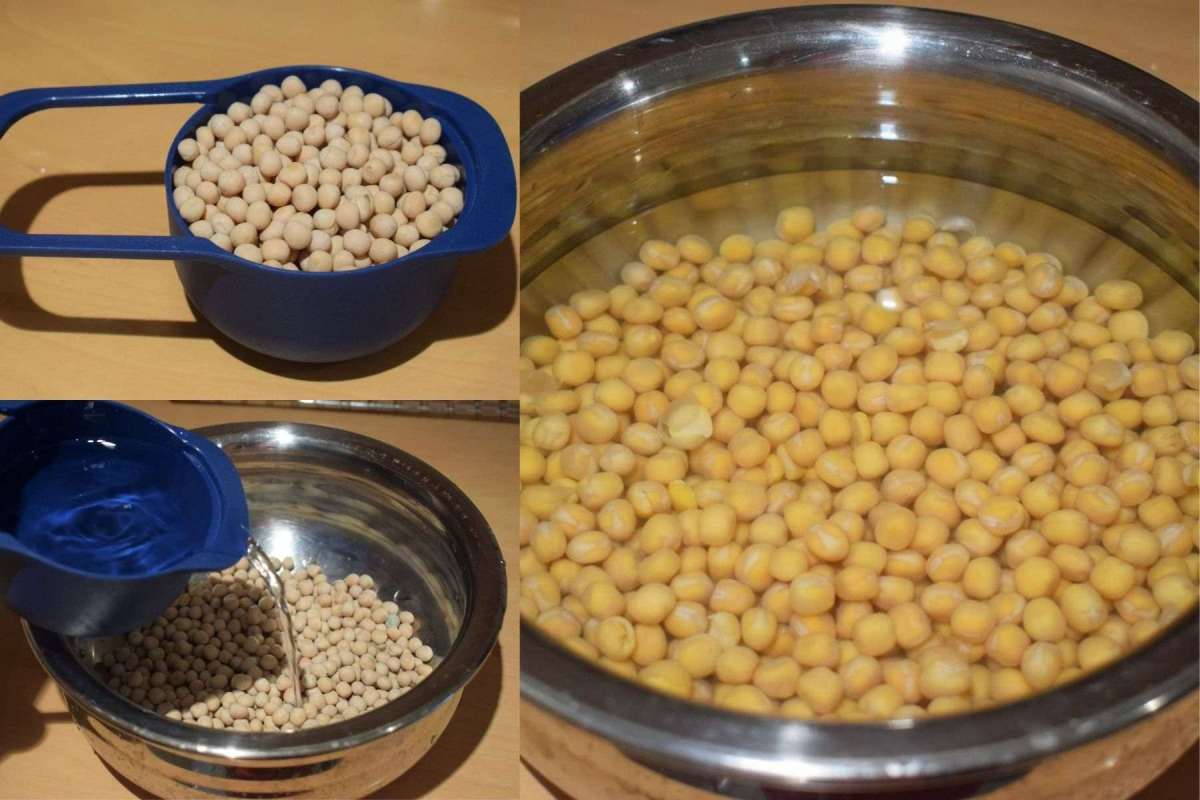
- Shift the soaked peas into a pressure cooker. Add 2½ cups of water, 1 teaspoon salt and ½ teaspoon turmeric powder, one by one into the pressure cooker. Give a stir and close the lid of the pressure cooker.
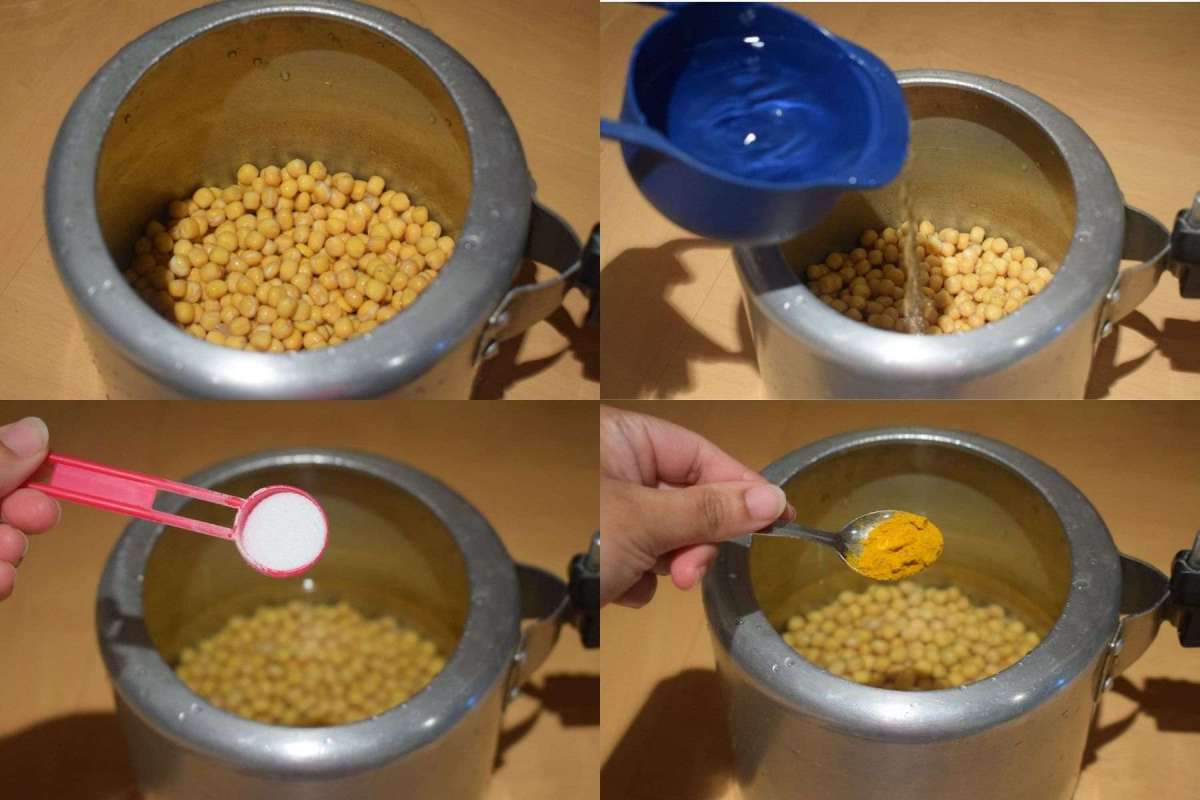
- Put the pressure cooker on medium flame and cook it till 2-3 whistles. Allow the pressure cooker to stand and release the pressure completely.

Note: For a good ghugni, the peas get just boiled and remain whole. Don’t overcook them or else you will not get the perfect texture. - Separate the boiled peas and the stock into two different utensils.
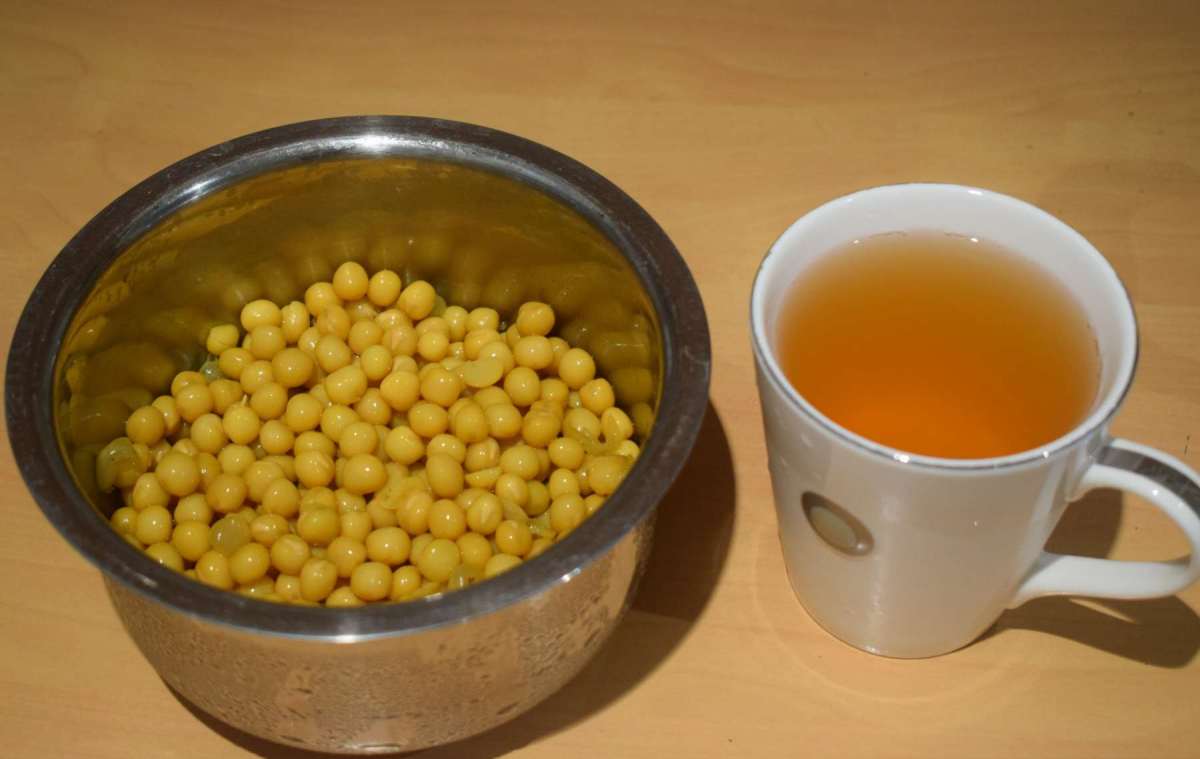
- Put a pan on flame and allow it to become completely dry.
- Add 2 tablespoons of mustard oil into the pan and wait until the oil is hot.
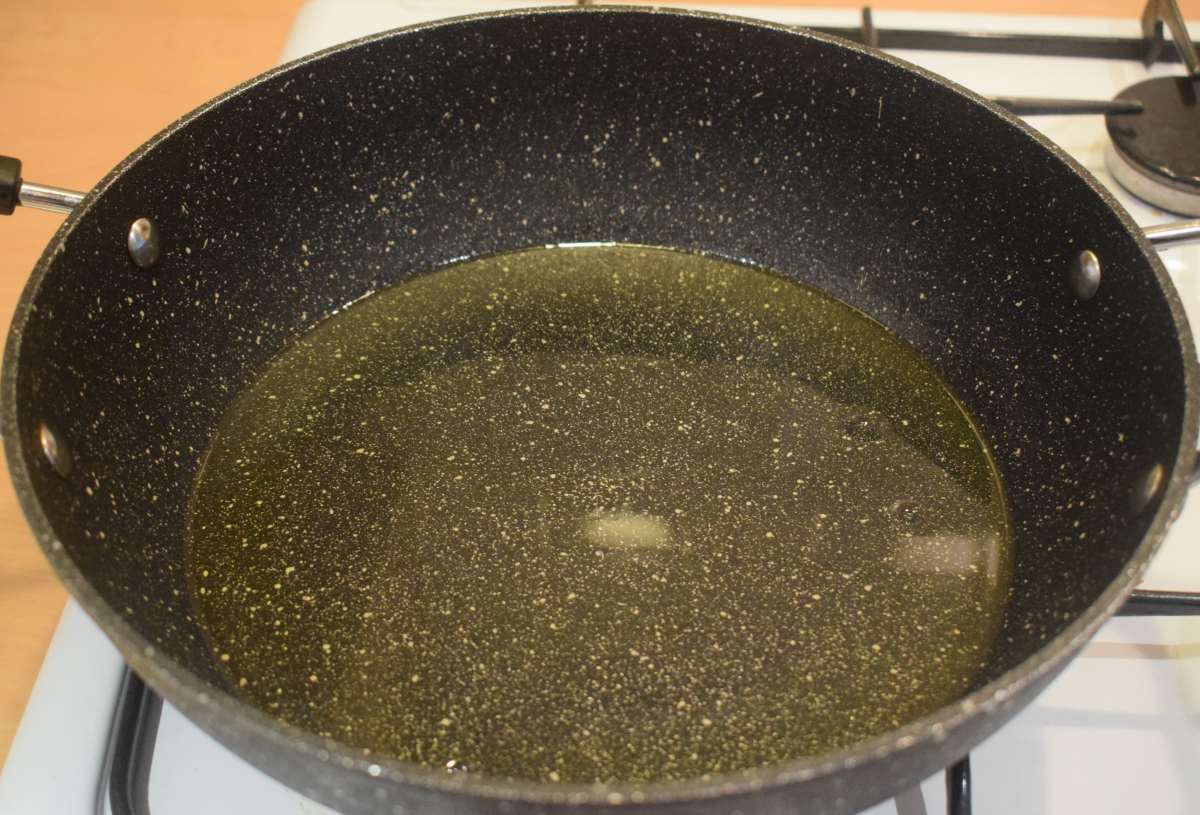
- Once the oil is hot, add 2 dry red chillies, 1 bay leaf, 1-inch cinnamon stick, ½ teaspoon cumin seeds into the pan and let them crackle.
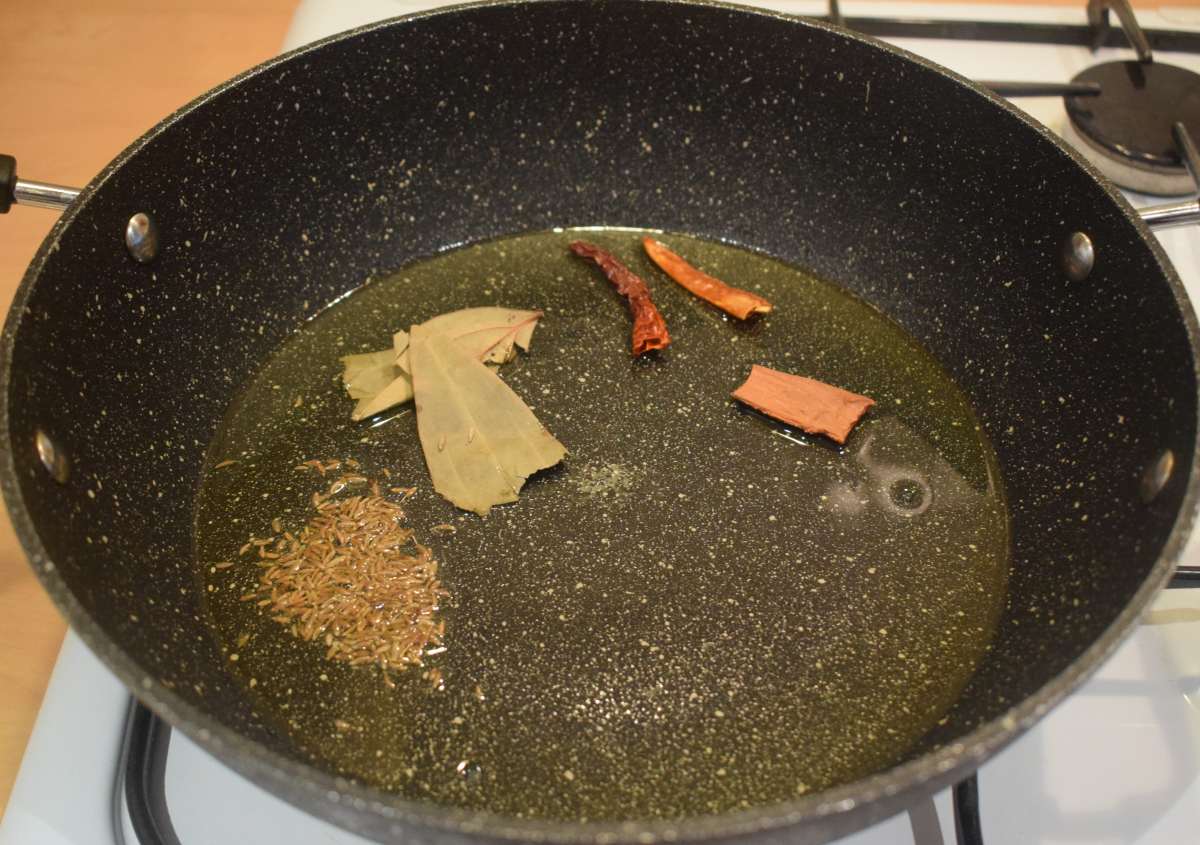
- Add potato chunks into the pan and give a nice stir. Cook it in medium-high flame for a minute.
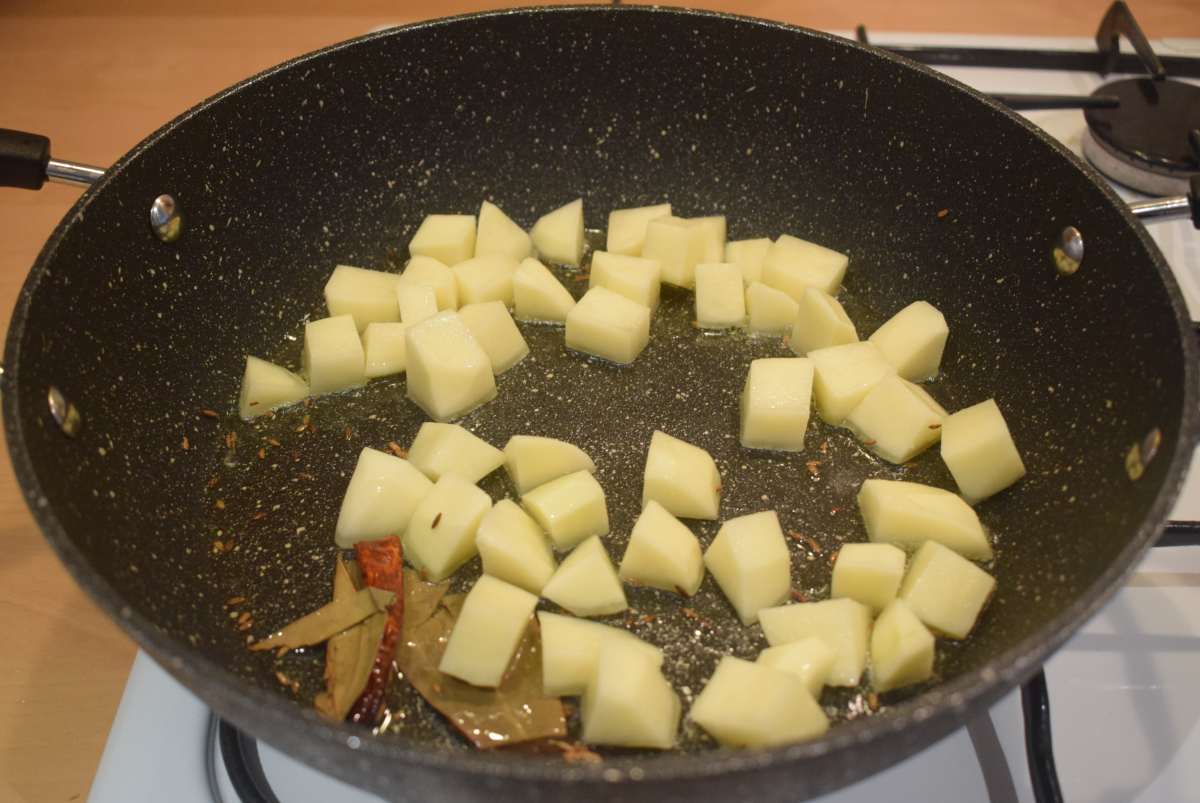
- Add salt, turmeric powder, red chilli powder into the pan and mix it well. Cook it in medium flame for another 2-3 minutes.
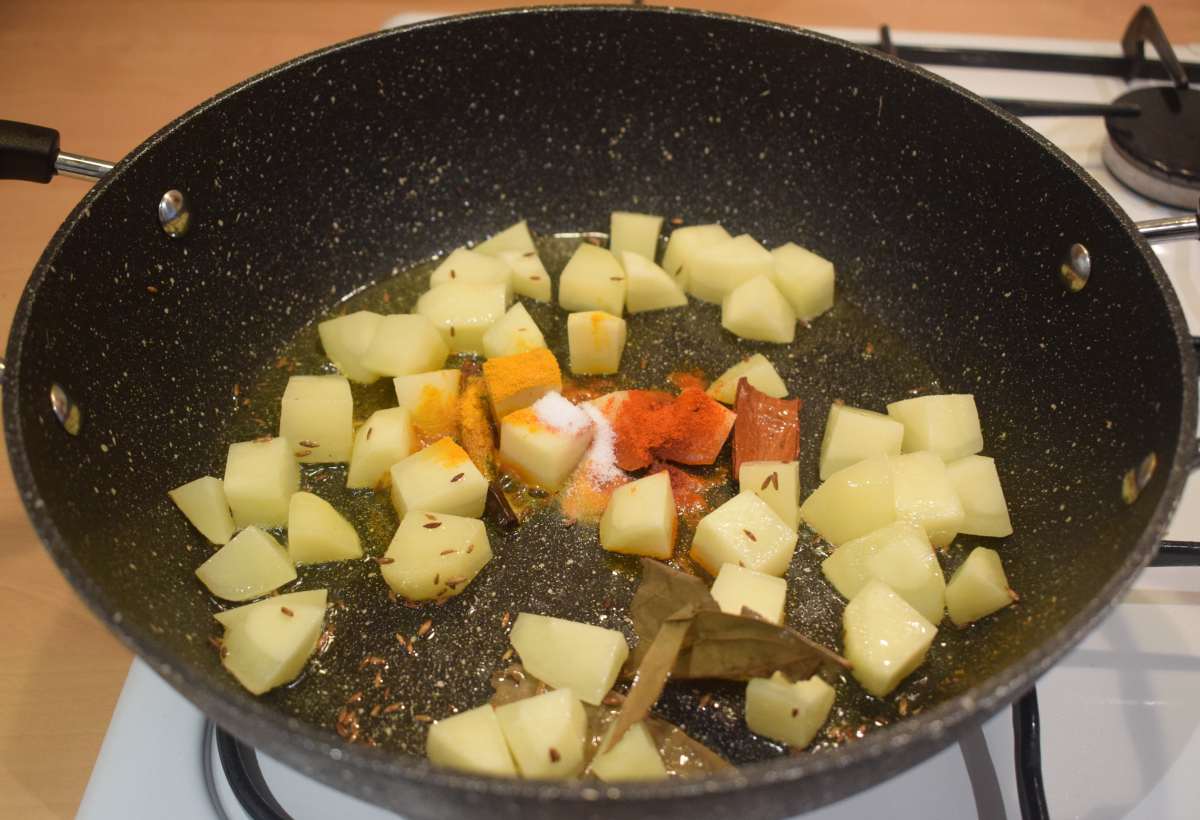
- Add ginger paste and give a nice stir. Cook it in low flame for another couple of minutes so that the raw smell disappears.
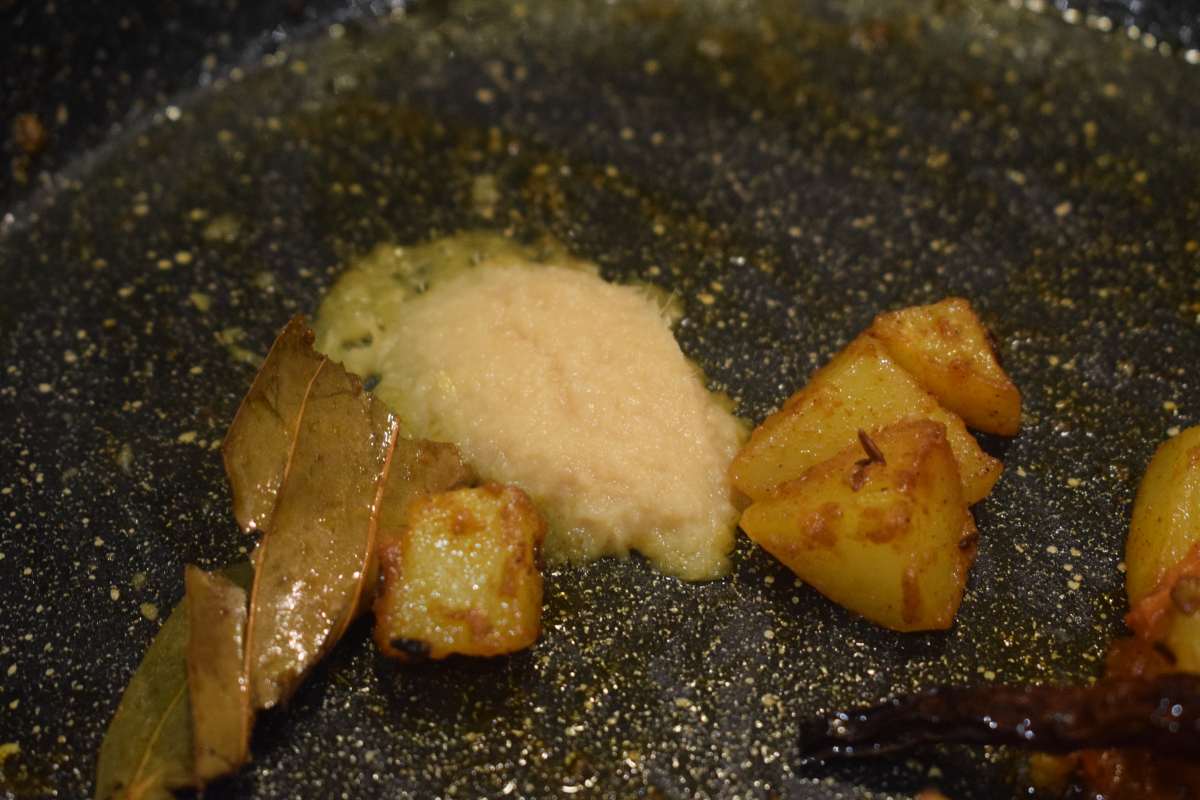
- Add tomato pieces, green chillies into the pan and mix it well. Cover the pan and cook it on low flame for 2-3 minutes until the tomatoes get soft.
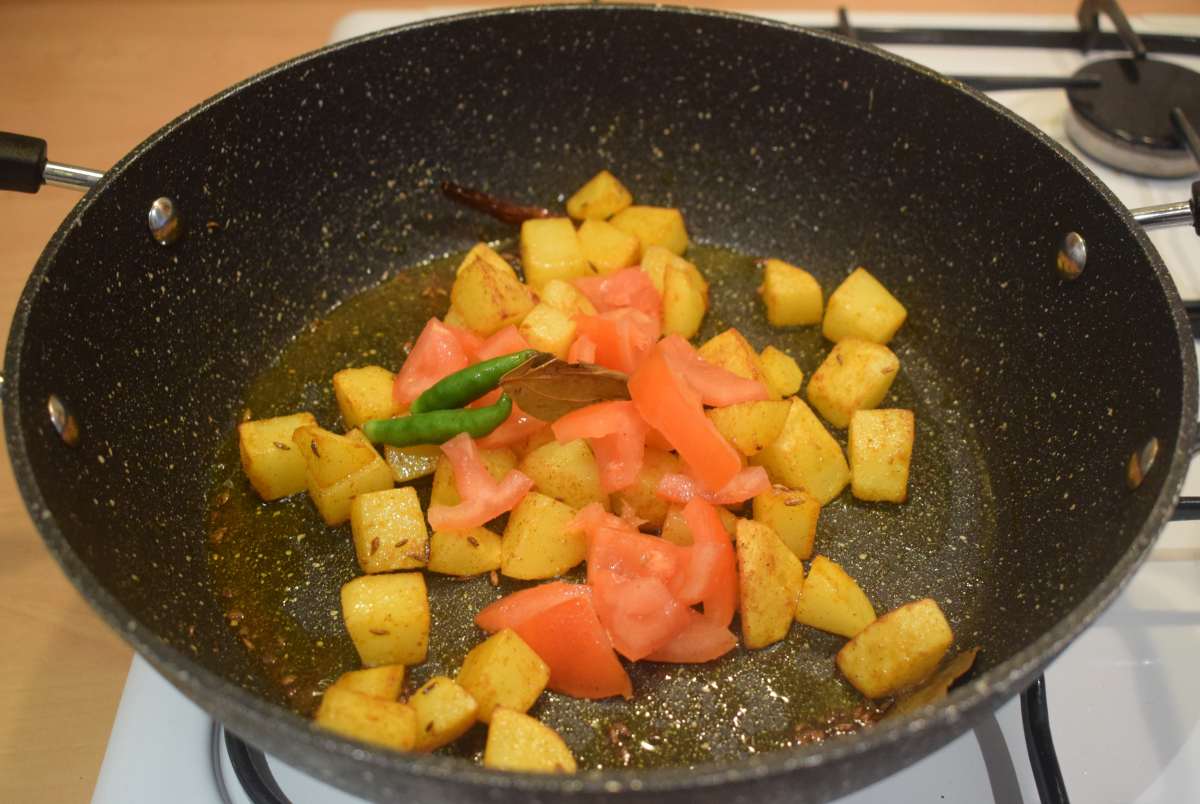
- Add cumin powder, coriander powder into the pan and mix it well. Cook the masala in the lowest flame for 1-2 minutes.
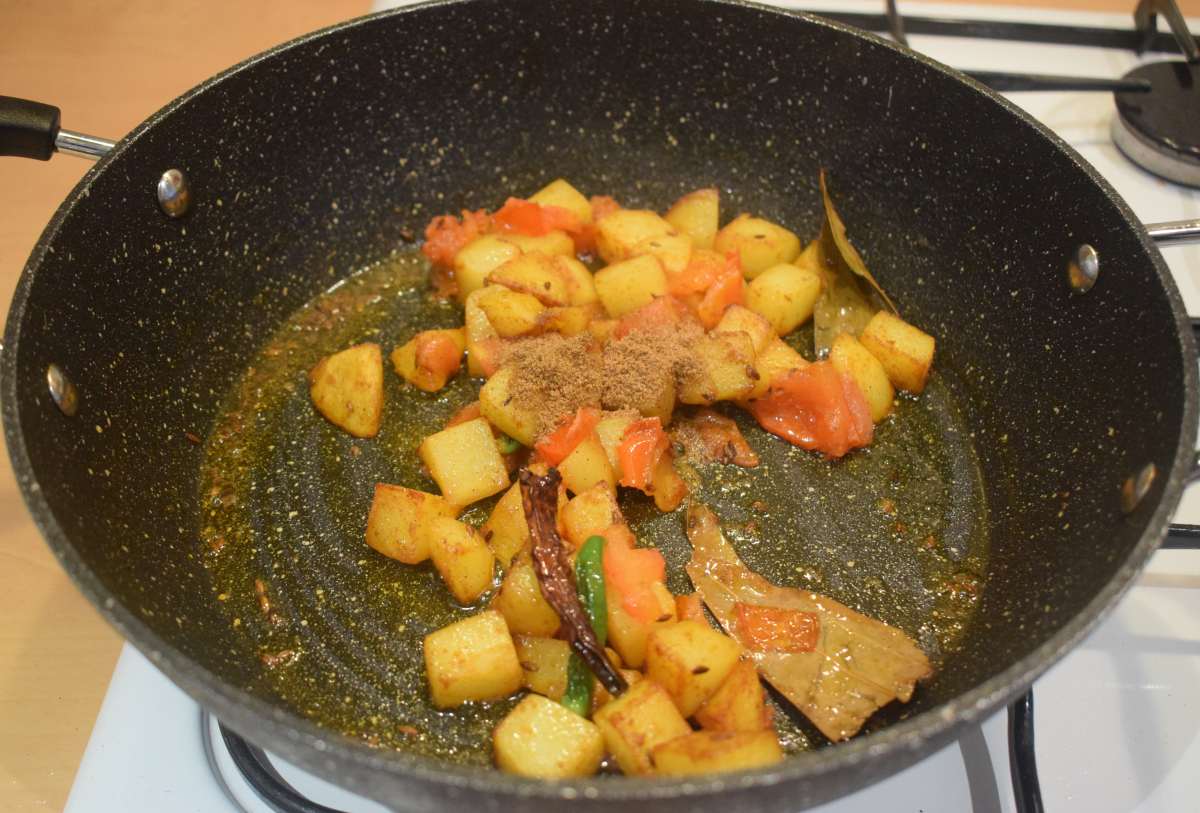
- Add boiled yellow peas (step 4) into the pan and mix them well. Cover the pan and cook it for another couple of minutes.
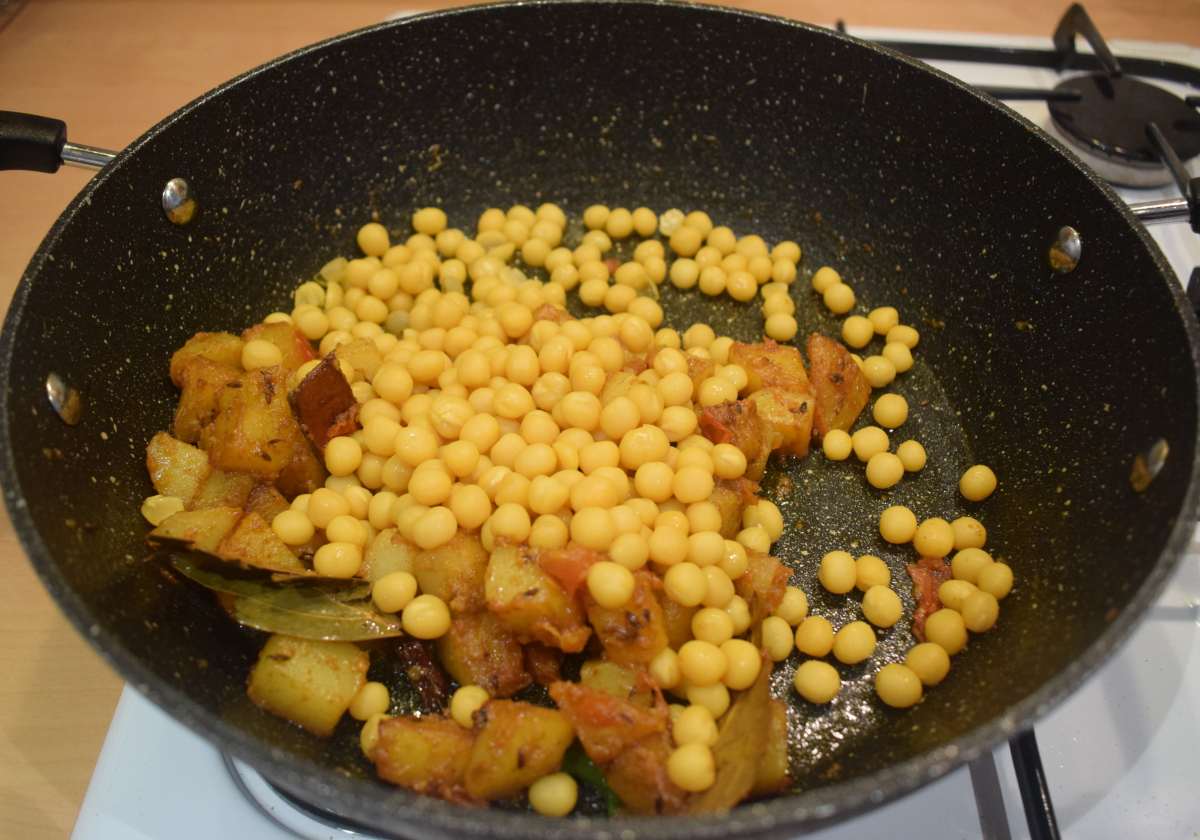
- Add the boiled yellow pea stock (step 4) into the pan and give a nice stir. Cover the pan and allow the gravy to boil.
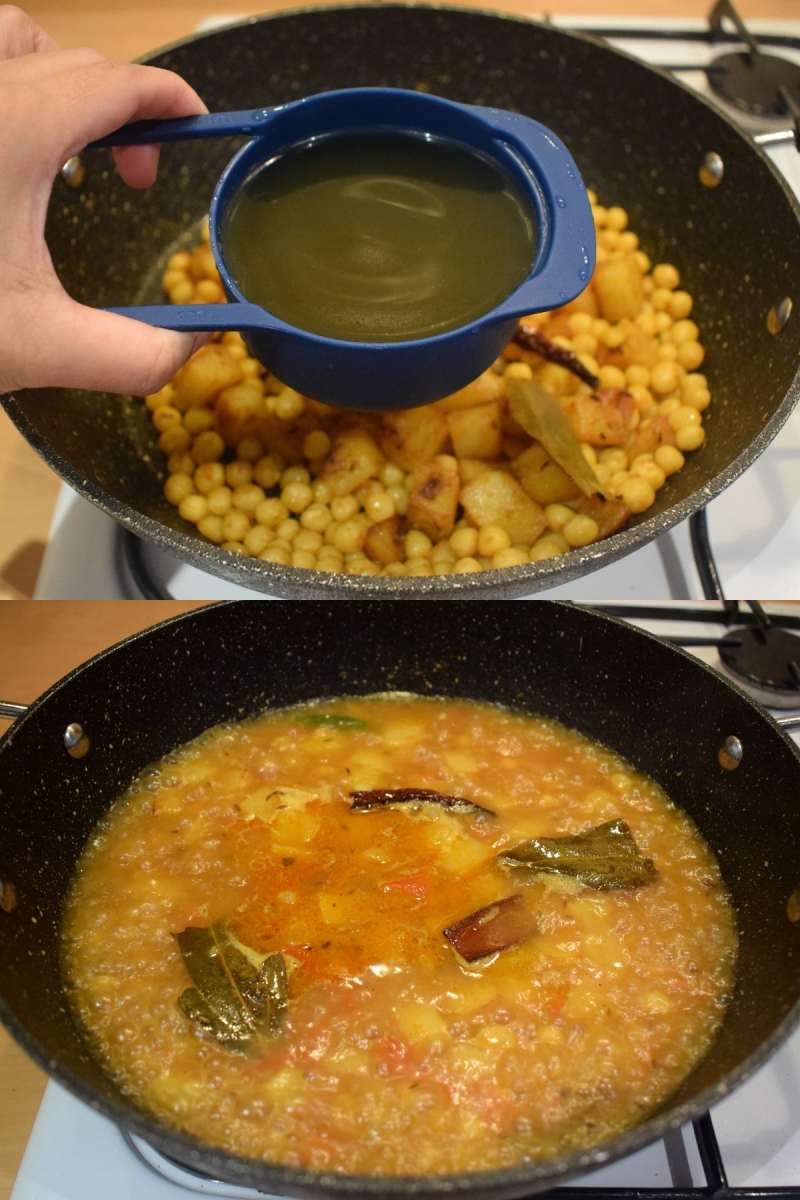
- Put the flame in low and add 1 teaspoon sugar, ½ tablespoon bhaja masala, ¼ teaspoon garam masala powder into it and give a nice mix. Allow the gravy to simmer at the lowest flame for another 2-3 minutes.
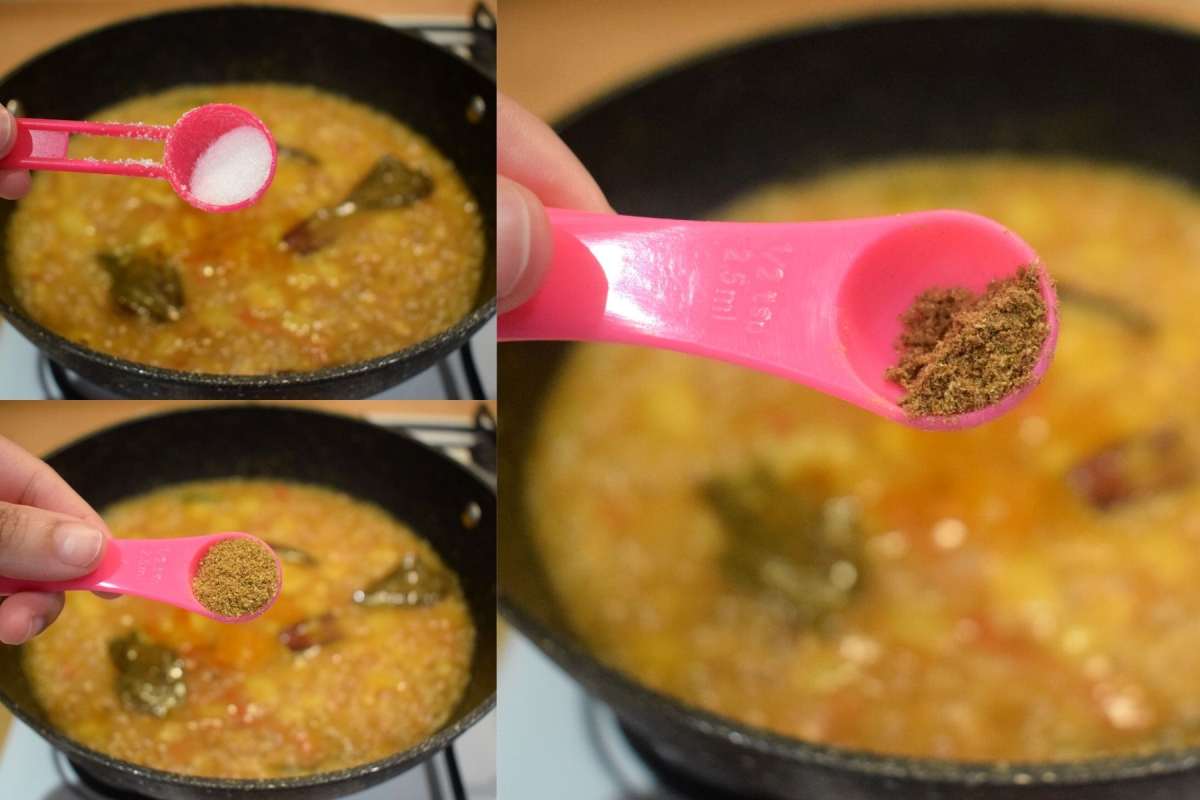
- Switch off the flame and put the pan down.
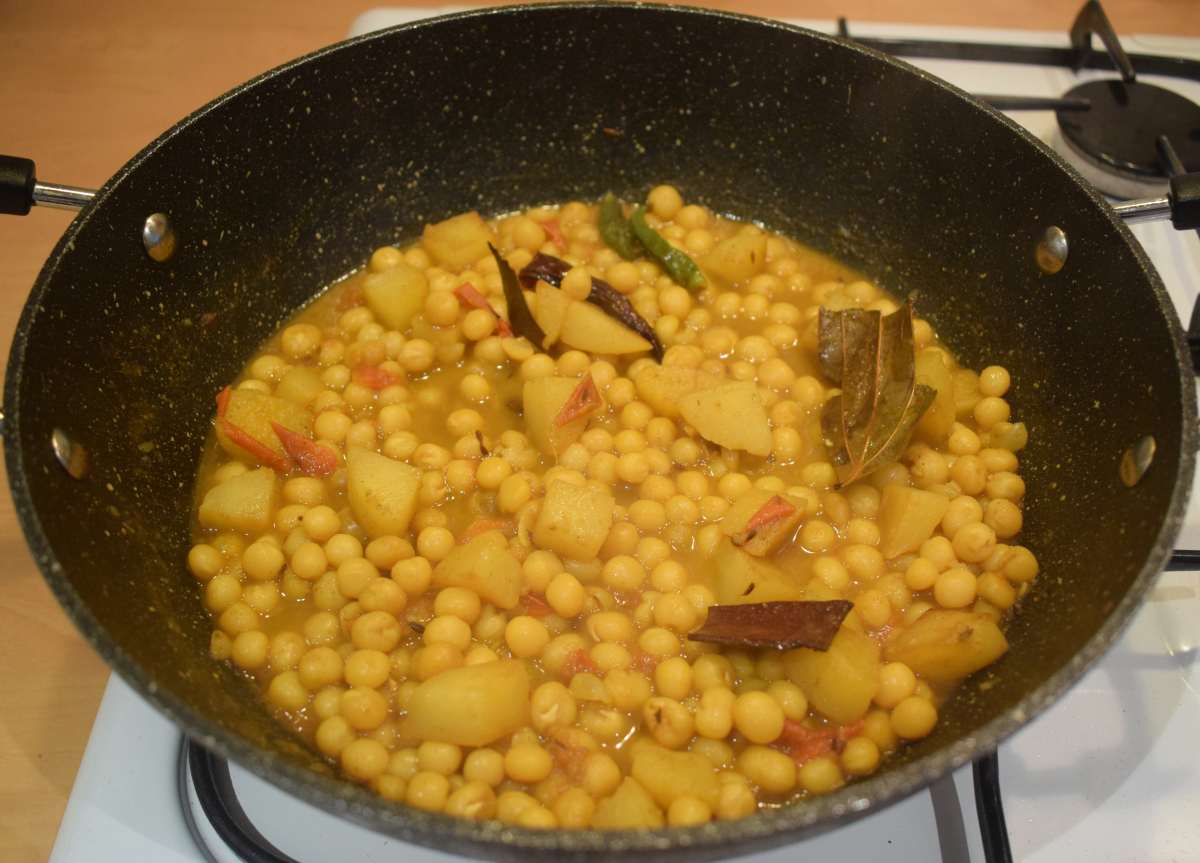
How to store ghugni?
You can store the niramish ghugni in an airtight container and refrigerate for 2 days but make sure to not add raw onions, cucumber or raw green chillies into it before storing. Even you can make the ghugni frozen after cooling down and store it in the freezer for 3-4 weeks. Thaw them and heat them in the oven or microwave before use.
Serving Instruction
Transfer the niramish ghugni recipe into a bowl. Serve it simply as a vegan snacks or pair it up with some luchi or pooris and enjoy the Bengali breakfast.
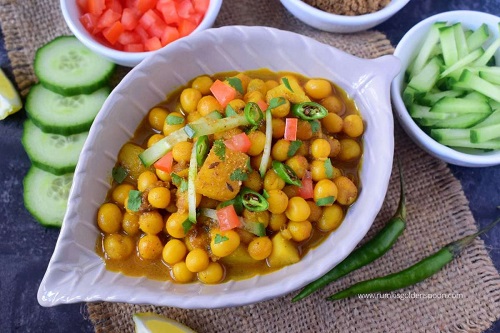
Ingredients
To pressure cook the peas
- 1 cup dried white or yellow Peas
- 2½ cups Water
- ½ teaspoon Turmeric powder
- 1 teaspoon Salt
Other ingredients for Niramish ghugni
- 1 large Potato, medium diced
- 1 large Tomato, deseeded and diced
- ½ tablespoon Ginger paste
- 2 green Chillies, whole or half slit
- 1 Bay leaf
- 2 dry red Chillies
- 1-inch Cinnamon stick
- ½ teaspoon Cumin seeds
- ½ teaspoon Turmeric powder
- 1 teaspoon red Chilli powder
- ½ teaspoon Cumin powder
- ½ teaspoon Coriander powder
- ¼ teaspoon Garam masala powder
- ½ tablespoon Bhaja masala
- 1 teaspoon Sugar
- 2 cups boiled pea stock, for the gravy
- 2 tablespoons Mustard oil, for cooking
Instructions
- Take the dried peas in a large bowl and soak them with enough water overnight or at least for 8 hours. The dried peas will increase in size after getting soaked. So, it is important to soak it in a large bowl as compared to the volume of the dried peas. Drain the water and wash the soaked peas nicely.
- Shift the soaked peas into a pressure cooker. Add 2½ cups of water, 1 teaspoon salt and ½ teaspoon turmeric powder, one by one into the pressure cooker. Give a stir and close the lid of the pressure cooker.
- Put the pressure cooker on medium flame and cook it till 2-3 whistles. Allow the pressure cooker to stand and release the pressure completely. Note: For a good ghugni, the peas get just boiled and remain whole. Don’t overcook them or else you will not get the perfect texture.
- Separate the boiled peas and the stock into two different utensils.
- Put a pan on flame and allow it to become completely dry.
- Add 2 tablespoons of mustard oil into the pan and wait until the oil is hot.
- Once the oil is hot, add 2 dry red chillies, 1 bay leaf, 1-inch cinnamon stick, ½ teaspoon cumin seeds into the pan and let them crackle.
- Add potato chunks into the pan and give a nice stir. Cook it in medium-high flame for a minute.
- Add salt, turmeric powder, red chilli powder into the pan and mix it well. Cook it in medium flame for another 2-3 minutes.
- Add ginger paste and give a nice stir. Cook it in low flame for another couple of minutes so that the raw smell disappears.
- Add tomato pieces, green chillies into the pan and mix it well. Cover the pan and cook it on low flame for 2-3 minutes until the tomatoes get soft.
- Add cumin powder, coriander powder into the pan and mix it well. Cook the masala in the lowest flame for 1-2 minutes.
- Add boiled yellow peas (step 4) into the pan and mix them well. Cover the pan and cook it for another couple of minutes.
- Add the boiled yellow pea stock (step 4) into the pan and give a nice stir. Cover the pan and allow the gravy to boil.
- Put the flame in low and add 1 teaspoon sugar, ½ tablespoon bhaja masala, ¼ teaspoon garam masala powder into it and give a nice mix. Allow the gravy to simmer at the lowest flame for another 2-3 minutes.
- Switch off the flame and put the pan down.
KITCHEN TOOLS for the recipe:
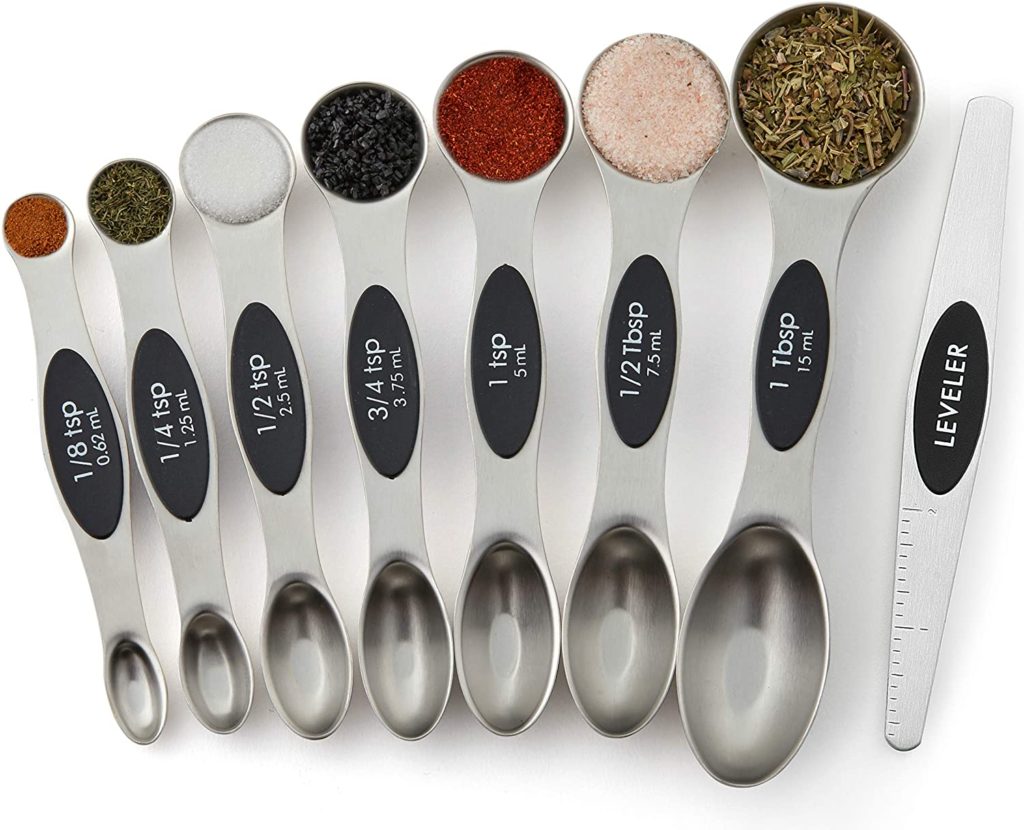
Measuring Spoons
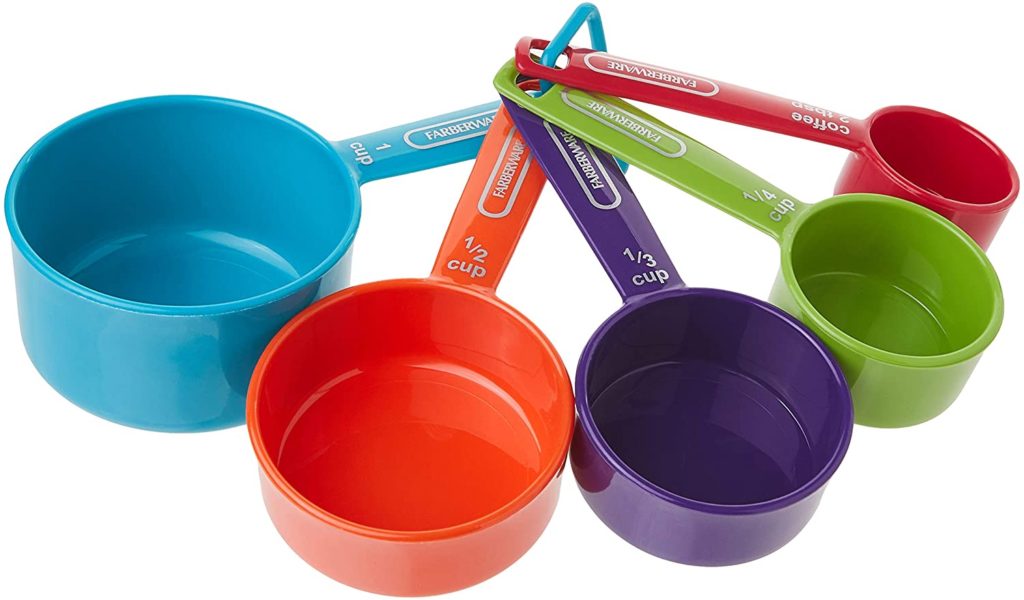
Measuring Cups
